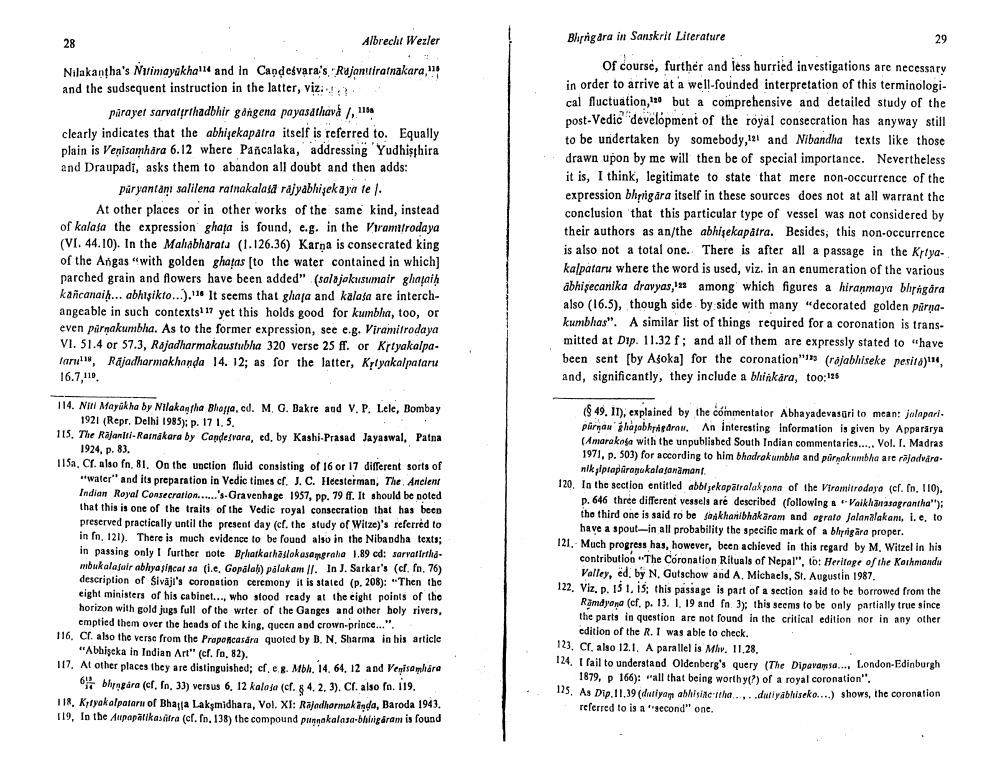________________
Blirrigara in Sanskrit Literature
Albrecht Wezler Nilakantha's Nitinayakhali and in Candesvara's Rajantiratnakara... and the sudsequent instruction in the latter, viz...
pirayer sarvatrhadbhir gångena payasathavá / 11 clearly indicates that the abhisekapatra itself is referred to. Equally plain is Venisamhara 6.12 where Pancalaka, addressing Yudhishira and Draupadt, asks them to abandon all doubt and then adds:
püryantani salilena ratnakalasa rajyabhişek aya tel.
At other places or in other works of the same kind, instead of kalata the expression ghata is found, e.g. in the Viram irodaya (VI. 44.10). In the Mahabharata (1.126.36) Karna is consecrated king of the Angas "with golden ghagas [to the water contained in which) parched grain and flowers have been added" (saldjakusumair gharaih kañcanai... abhişikto...). It seems that ghaja and kalasa are interchangeable in such contexts 17 yet this holds good for kumbha, too, or even pirakumbha. As to the former expression, see e.g. Viramitroda ya VI. 51.4 or 57.3, Rajadharmakaustubha 320 verse 25 fr. or Krtyakalpafan , Rajadharmakhanda 14. 12; as for the latter, Kylyakalpataru 16.7,110.
of course, further and less hurried investigations are necessary in order to arrive at a well-founded interpretation of this terminological fluctuation, but a comprehensive and detailed study of the post-Vedic development of the royal consecration has anyway still to be undertaken by somebody,121 and Nibandha texts like those drawn upon by me will then be of special importance. Nevertheless it is, I think, legitimate to state that more non-occurrence of the expression bhrrigara itself in these sources does not at all warrant the conclusion that this particular type of vessel was not considered by their authors as an/the abhisekapátra. Besides, this non-occurrence is also not a total one. There is after all a passage in the Krtyakalpataru where the word is used, viz. in an enumeration of the various abhi secanika dravyas,'*among which figures a hiranmaya blir gåra also (16.5), though side by side with many "decorated golden parnakumbhas". A similar list of things required for a coronation is transmitted at Dip. 11.32f; and all of them are expressly stated to "have been sent [by Asoka) for the coronation"» (röjabhiseke pesita)"", and, significantly, they include a blinkara, too:15
114. NIW Mayük ha by Nilakantha Bhaja, ed. M. G. Bakre and V. P. Lele, Bombay
1921 (Repr. Delhi 1985): p. 171.5. 115. The Rajantti-Ratnakara by Candesrara, ed. by Kashi-Prasad Jayaswal, Patna
1924, p. 83. 115a. C. also fn, 81, On the upction fluid consisting of 16 or 17 different sorts of
"water" and its preparation in Vedic times cl, J. C. Heesterman, The Ancient Indian Royal Consecration...... 's-Gravenhage 1957, pp. 79 . It should be noted that this is one of the traits of the Vedic royal consecration that has been preserved practically until the present day (cf. the study of Witze)'s referred to in In, 121). There is much evidence to be found also in the Nibandha texts; in passing only I further note Brhatkarhaslokasampraha 1.89 cd: sarvatirthambukalafuir abhyasincat sa (le, Gopalah) palakam //. In J. Sarkar's (cf. fn. 76) description of Sivaji's coronation ceremony it is stated (p. 208): "Then the
or his cabinet..., who stood ready at the eight points of the horizon with gold jugs full of the wrter of the Ganges and other boly rivers,
emptied them over the bends of the king, queen and crown-prince...". 116. Cr. also the verse from the Prapancasăra quoted by B. N, Sharma in his article
"Abhiseka in Indian Art" (cf. fo, 82). 117. At other places they are distinguished; cf. e R. Mbl. 14.64.12 and Venisamlara
bhagara (cf. n. 33) versus 6. 12 kalaja (cf. 4.2.3). Cf. also fn. 119. TIR. Kyyakalpataru of Bhala Laksmidhara, Vol. XI: Rajadharmakanda, Baroda 1943. 119, In the supapātikasitra (cf. n. 138) the compound pinnakalasabhindram is found
(49, 1T), explained by the commentator Abhayadevasürito mean: jolapari. püran Bhajabhadraw. An interesting information is given by Apparirya (Amarekoga with the unpublisbed South Indian commentaries..... Vol. I. Madras 1971, p. 503) for according to him bhadrakumbha and purnakumbha are rajadvara
nikpipraparonokalafanaman 120. In the section entitled abbisekapātralak sona of the Viramitrodoya (cf. n. 110).
p. 646 three different vessels are described (following & Vaikhanagrantha"); the third one is said robe saskhanibhakaram and opralo Jalanalakanı, i.e. to
have a spout-in all probability the specific mark of a blyrigåra proper. 121. Much progress has, however, been achieved in this regard by M, Witzel in his
contribution The Coronation Rituals of Nepal", to: Heritage of the Kathmandu
Valley, ed. by N. Gutschow and A. Michaels, St. Augustin 1987. 122. Viz. p. 151, IS: this passage is part of a section said to be borrowed from the
Ramdyana (cf. p. 13. 1. 19 and fn. 3); this seems to be only partially true since the parts in question are not found in the critical edition nor in any other
edition of the R. I was able to check. 123. Cr, also 12.1. A parallel is Mh. 11.28. 124. I fail to understand Oldenberg's query (The Dipavamsa.... London Edinburgh
1879, p 166): -all that being worthy of a royal coronation". 125, As Dip. 11,39 (dutiyan abhisic tha.....dutiyabhiseko....) shows, the coronation
referred to is a second one.
.




